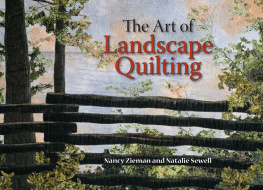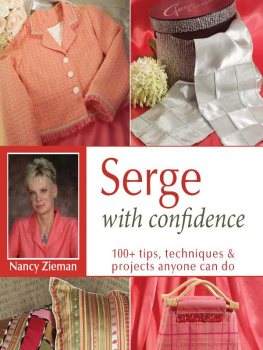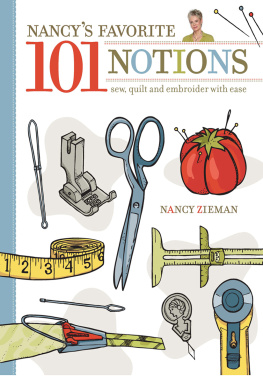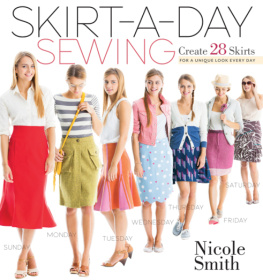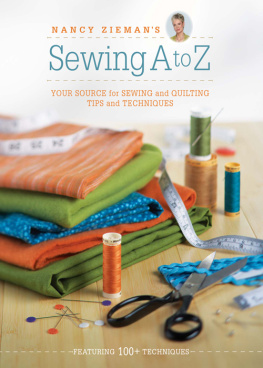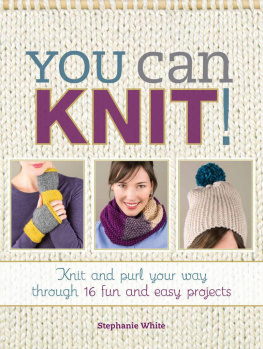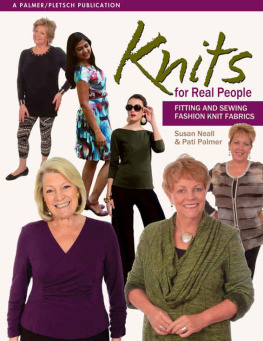

Contents

Introduction
It was the late 1960s. The hot topics in the sewing industry were knit fabrics and knit patterns. I was a young girl, just learning to sew. My mom was intrigued with the thought of sewing T-shirts, knit dresses and underwearyes, tricot undies.
What needle do I use? How do you stitch the seams so they dont pop? Are there pressing pointers? These were the questions asked by sewing enthusiasts. The answers to these questions respectively were: Use a ballpoint needle (a new revelation). Set your machine for a narrow zigzag stitch. And finally, press lightly with a much cooler iron than youre accustomed to using.
Fast-forward almost fifty years. Knit fabrics and knit patterns are enjoying a resurgence in popularity. A greater range of knit fabrics is at our disposal. New sewists are trying knits for the first time and have questions. Others are rediscovering the ease and simplicity of sewing with knit fabrics, but would like a refresher course.
Sew Knits With Confidence is a technique and confidence-building book rolled into one, targeted for any level of knit sewist. Start with the basics and sew a simple knit top. Or, strive to be a designer by adding a flounce to your favorite knit pattern. Sewing confidence is only a page turn away.
Nancy


Chapter 1
Knit Fabrics
Comfy knit clothing is easy to sew and fit, plus knit fabric needs less pressing and care than most other fabric. There is such a variety of knits that basically every hour of a day can be spent in total comfortpajamas, sportswear, undergarments, workwear and even elegant eveningwear. From lightweight tricot to heavy berberthe gamut is amazing!

Fabric types
Knits are made from natural and/or synthetic fibers. The construction, fabrication and weight determine the type of knit. The blend of fibers, colors and prints is seemingly endless. Knits are comfortable to wear, easy to sew and require very little care. The charisma of specialty knit fabrics is immediate, and the softness unforgettable.
Single knit

Single knits are sometimes referred to as jersey knits. They are suitable for T-shirts, dresses, pull-on pants and shorts, and sleepwear.
Single knit qualities:
Lightweight
2550% stretch
One side of the fabric looks like a knit stitch; the other resembles interlocking loops.
Single knits have flat vertical ribs on the right side (a lengthwise chain stitch) and horizontal lines (crosswise half-loops) on the wrong side.
Single knits curl to the right side when pulled on the crosswise grain. This can be an advantage, because it is easy to find the right side when seaming your fabric.
The surface of single knits is flat and works well for printing.
Good draping quality is inherent in single knits, and they are somewhat stretchy and resistant to creasing.
Rayon jersey knits are softer and finer than cotton jersey, but care must be taken when washing because rayon fibers are weak when they are wet.
Stretch types
For all practical purposes, knit fabrications are classified by the amount of stretch that they possess.
Firm stable knits. These knits have very little stretch and may be used much like woven fabrics when choosing a pattern. Some examples are double knit, sweatshirt fleece and raschel knit.
Moderate stretch knits. The typical amount of stretch in a knit considered to have a moderate stretch is about 25%. Some examples of these are single, tricot and interlock knits.
Two-way stretch knits. These knits are quite stretchy and usually include spandex. They stretch in both lengthwise and crosswise directions about 5075%. Examples include fabrics used for swimwear and bicycle shorts.
Super-stretchy knits. Super-stretchy fabrics may stretch 75100% in width and 50100% in length. Examples include slinky knit and knits used for ski wear.
Interlock knit

Interlock knits are a little heavier than single knits and have up to 50% stretch, making them perfect for pants, jackets, tops and sleepwear.
Interlock knit qualities:
11 knit construction like double knits, but lighter in weight with a soft hand
Note: Because of their construction, interlock knits look the same on both sideslike a very fine rib.
Usually 100% cotton or a 50/50 cotton-polyester blend
Stretch on the crosswise grain, but little or no stretch on the lengthwise grain
Note: Pretreat interlock knits before using them, especially those that are 100% cotton, to avoid shrinkage after the clothing is sewn.
Double knit

Double knits are beefier, or heavier, than single or interlock knits. These knits are great for designs that need more body such as jackets, pants, dresses and skirts.
Double knit qualities:
Less than 25% stretch
Firm, medium to heavyweight fabric
Looks the same on both front and back, like interlock
Stretch crosswise, but stable lengthwise
Ribbing

Ribbing has distinguishing vertical ribs on both sides of the fabric and is very stretchy100% crosswise stretch. Ribbing is typically used to finish necklines, waistlines, armholes, and leg and sleeve hems of mainly knit garments. It is a knit/purl construction.
Ribbing types include:
11 rib knitKnit wales alternate evenly with one on one side and one on the other.
21 rib knitsTwo wales on one side and one on the other.
Baby ribVery fine ribbing, usually made with single spun combed cotton fibers. The surface of baby rib is smooth and finer than regular ribbing.
Note from Nancy
I make it a rule not to prewash ribbing, even if the fabric has a tendency to shrink. Shrinking in size after making the project will enhance the shaping.


